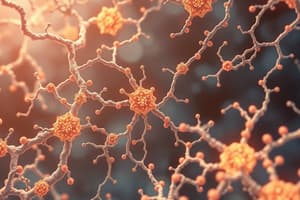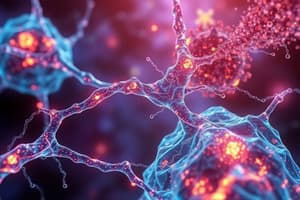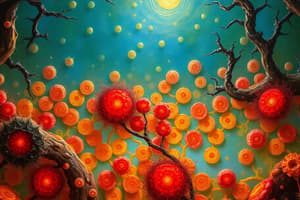Podcast
Questions and Answers
Which type of signaling involves a cell releasing a substance that affects its own activity?
Which type of signaling involves a cell releasing a substance that affects its own activity?
- Endocrine signaling
- Paracrine signaling
- Autocrine signaling (correct)
- Synaptic signaling
Which type of collagen is primarily found in the basement membrane?
Which type of collagen is primarily found in the basement membrane?
- Collagen type II
- Collagen type I
- Collagen type IV (correct)
- Collagen type III
What is the main function of proteoglycans and hyaluronan in the extracellular matrix?
What is the main function of proteoglycans and hyaluronan in the extracellular matrix?
- Providing tensile strength and recoil
- Connecting matrix elements to each other and to cells
- Providing hydration and swelling pressure (correct)
- Acting as signaling molecules
Which of the following statements about growth factors is TRUE?
Which of the following statements about growth factors is TRUE?
How do growth factors promote entry into the cell cycle?
How do growth factors promote entry into the cell cycle?
Which of these is NOT true about the extracellular matrix (ECM)?
Which of these is NOT true about the extracellular matrix (ECM)?
Which type of signaling is involved when hormones travel through the bloodstream to reach their target cells?
Which type of signaling is involved when hormones travel through the bloodstream to reach their target cells?
Which of the following is NOT a role of the ECM during wound healing?
Which of the following is NOT a role of the ECM during wound healing?
Which of the following growth factors is NOT released during the hemostasis phase of wound healing?
Which of the following growth factors is NOT released during the hemostasis phase of wound healing?
What is the primary function of polymorphonuclear leukocytes (PMNs) during the inflammation phase of wound healing?
What is the primary function of polymorphonuclear leukocytes (PMNs) during the inflammation phase of wound healing?
Which of the following cells are responsible for the removal of dead PMNs from the wound site via apoptosis?
Which of the following cells are responsible for the removal of dead PMNs from the wound site via apoptosis?
Which of the following is a defining characteristic of the proliferation phase of wound healing?
Which of the following is a defining characteristic of the proliferation phase of wound healing?
What is the primary function of fibroblasts during the proliferation phase of wound healing?
What is the primary function of fibroblasts during the proliferation phase of wound healing?
Which of the following events is NOT characteristic of the remodeling and maturation phase of wound healing?
Which of the following events is NOT characteristic of the remodeling and maturation phase of wound healing?
Which of the following factors can potentially lead to delayed wound healing?
Which of the following factors can potentially lead to delayed wound healing?
Which of the following is NOT directly involved in re-epithelialization?
Which of the following is NOT directly involved in re-epithelialization?
What is the primary function of angiogenesis in wound healing?
What is the primary function of angiogenesis in wound healing?
Which of the following factors is NOT primarily responsible for initiating endothelial cell migration during angiogenesis?
Which of the following factors is NOT primarily responsible for initiating endothelial cell migration during angiogenesis?
What is the significance of the leakiness of newly formed blood vessels in wound healing?
What is the significance of the leakiness of newly formed blood vessels in wound healing?
Which of the following is NOT a characteristic of granulation tissue?
Which of the following is NOT a characteristic of granulation tissue?
What is the primary role of fibroblasts in wound healing?
What is the primary role of fibroblasts in wound healing?
After wound healing is complete, what happens to the many nonfunctional blood vessels that were formed during angiogenesis?
After wound healing is complete, what happens to the many nonfunctional blood vessels that were formed during angiogenesis?
Which of the following best describes the relationship between the wound healing processes of re-epithelialization and angiogenesis?
Which of the following best describes the relationship between the wound healing processes of re-epithelialization and angiogenesis?
What is the primary function of fibroblasts in the wound healing process?
What is the primary function of fibroblasts in the wound healing process?
Why is the extracellular matrix (ECM) important for the maintenance of blood vessels?
Why is the extracellular matrix (ECM) important for the maintenance of blood vessels?
Which of the following is NOT a key cytokine involved in the remodeling phase of wound healing?
Which of the following is NOT a key cytokine involved in the remodeling phase of wound healing?
How does oxygen contribute to the formation of mature collagen in wound healing?
How does oxygen contribute to the formation of mature collagen in wound healing?
What is the main reason for the reduction in cellularity at the wound site during the remodeling phase?
What is the main reason for the reduction in cellularity at the wound site during the remodeling phase?
What distinguishes healing by first intention from healing by second intention?
What distinguishes healing by first intention from healing by second intention?
What is the primary role of contractile fibroblasts (myofibroblasts) during wound healing?
What is the primary role of contractile fibroblasts (myofibroblasts) during wound healing?
What are hypertrophic scars and keloids primarily a result of?
What are hypertrophic scars and keloids primarily a result of?
Which of these cell types can regenerate after injury, but only to a limited extent?
Which of these cell types can regenerate after injury, but only to a limited extent?
Which of the following is NOT a defining characteristic of labile cells?
Which of the following is NOT a defining characteristic of labile cells?
Permanent cells, unlike labile and stable cells, are characterized by their inability to:
Permanent cells, unlike labile and stable cells, are characterized by their inability to:
Which of the following is an example of a tissue that primarily relies on repair rather than regeneration after injury?
Which of the following is an example of a tissue that primarily relies on repair rather than regeneration after injury?
Which of the following BEST describes the process by which damaged tissue is restored to its original state?
Which of the following BEST describes the process by which damaged tissue is restored to its original state?
What is the main reason why labile cells can regenerate more easily than stable cells?
What is the main reason why labile cells can regenerate more easily than stable cells?
Which of the following statements is TRUE about the healing process?
Which of the following statements is TRUE about the healing process?
Which of the following is a defining characteristic of the repair process?
Which of the following is a defining characteristic of the repair process?
Which of the following conditions is NOT a systemic factor that can impede wound healing?
Which of the following conditions is NOT a systemic factor that can impede wound healing?
Which of the following best describes the difference between a hypertrophic scar and a keloid?
Which of the following best describes the difference between a hypertrophic scar and a keloid?
What is the underlying cause of dehiscence, a complication of wound healing?
What is the underlying cause of dehiscence, a complication of wound healing?
Which of the following is a potential consequence of chronic wound infection?
Which of the following is a potential consequence of chronic wound infection?
Which of the following is a specific example of a neoplasia arising from a wound?
Which of the following is a specific example of a neoplasia arising from a wound?
Which of the following factors directly influences the effectiveness of wound healing by promoting granulation tissue formation?
Which of the following factors directly influences the effectiveness of wound healing by promoting granulation tissue formation?
Which of the following scenarios is LEAST likely to contribute to wound dehiscence?
Which of the following scenarios is LEAST likely to contribute to wound dehiscence?
Which statement MOST accurately reflects the impact of nutrition on wound healing?
Which statement MOST accurately reflects the impact of nutrition on wound healing?
Drugs that block Nicotinic Ach Recpetors and other examples which block Nicotinic Ach receptors
Drugs that block Nicotinic Ach Recpetors and other examples which block Nicotinic Ach receptors
Drugs blocking muscarnic Ach receptors
Drugs blocking muscarnic Ach receptors
Clinical significance of Acetylcholine
Clinical significance of Acetylcholine
What are the 4 bioamine neurotransmitters
What are the 4 bioamine neurotransmitters
What do amphetamines , Antidepressents , cocaine , Resperine do to norepinepphrines
What do amphetamines , Antidepressents , cocaine , Resperine do to norepinepphrines
Dopamine drugs relevance
Dopamine drugs relevance
SEROTONON Drugs
SEROTONON Drugs
Histamine drugs
Histamine drugs
Flashcards
Healing
Healing
The body's response to injury for restoring normal structure and function.
Regeneration
Regeneration
Process by which some tissues replace damaged components and return to a normal state.
Repair
Repair
Healing that occurs through proliferation of connective tissue, leading to fibrosis and scarring.
Labile Cells
Labile Cells
Cells that continuously divide and can easily regenerate after injury.
Signup and view all the flashcards
Stable Cells
Stable Cells
Cells that can multiply in response to stimuli but lose ability post-adolescence.
Signup and view all the flashcards
Permanent Cells
Permanent Cells
Cells that lose the ability to proliferate around birth and cannot regenerate.
Signup and view all the flashcards
Growth Factors
Growth Factors
Substances that are crucial for tissue repair and regeneration.
Signup and view all the flashcards
Wound Healing Process
Wound Healing Process
Sequence of events leading to the restoration of normal tissue after injury.
Signup and view all the flashcards
Function of ECM
Function of ECM
Extracellular matrix supports cells and regulates tissue structure.
Signup and view all the flashcards
Stages of Wound Healing
Stages of Wound Healing
Include hemostasis, inflammation, proliferation, and remodeling.
Signup and view all the flashcards
Hemostasis
Hemostasis
Immediate response with blood vessel constriction and clot formation.
Signup and view all the flashcards
Inflammation Phase
Inflammation Phase
Begins after hemostasis; influx of immune cells to prevent infection.
Signup and view all the flashcards
Cytokines in Inflammation
Cytokines in Inflammation
Proinflammatory signals like IL-1, IL-6, and TNF-α are released.
Signup and view all the flashcards
Proliferation Phase
Proliferation Phase
Rebuilding of the wound with new tissue, collagen, and extracellular matrix.
Signup and view all the flashcards
Macrophages
Macrophages
Immune cells that clear debris and support healing in inflammation.
Signup and view all the flashcards
Cell Division
Cell Division
The process by which a cell splits into two or more daughter cells.
Signup and view all the flashcards
Autocrine Signaling
Autocrine Signaling
Cell responds to signals it releases itself.
Signup and view all the flashcards
Paracrine Signaling
Paracrine Signaling
Signaling between adjacent cells, influencing their behavior.
Signup and view all the flashcards
Endocrine Signaling
Endocrine Signaling
Long-distance signaling via hormones carried in the blood.
Signup and view all the flashcards
Extracellular Matrix (ECM)
Extracellular Matrix (ECM)
A network of proteins surrounding cells vital for tissue structure and repair.
Signup and view all the flashcards
Fibrous Structural Proteins
Fibrous Structural Proteins
Proteins like collagen and elastin provide strength and elasticity to tissues.
Signup and view all the flashcards
Basement Membrane
Basement Membrane
A thin layer of ECM associated with epithelial and mesenchymal cells.
Signup and view all the flashcards
Wound contraction
Wound contraction
The process where a wound reduces in size as new tissues form.
Signup and view all the flashcards
Re-epithelialization
Re-epithelialization
Recovery of a wound involving migration and proliferation of keratinocytes.
Signup and view all the flashcards
Angiogenesis
Angiogenesis
The formation of new blood vessels from existing ones, vital for healing.
Signup and view all the flashcards
Granulation tissue
Granulation tissue
Tissue that forms in wounds, characterized by a pink, soft appearance and new capillaries.
Signup and view all the flashcards
Fibroblasts
Fibroblasts
Cells that proliferate in wounds to produce collagen and support tissue repair.
Signup and view all the flashcards
Collagen deposition
Collagen deposition
The process of connective tissue formation which provides strength to the wound area.
Signup and view all the flashcards
VEGF
VEGF
Vascular Endothelial Growth Factor; a key molecule that stimulates angiogenesis.
Signup and view all the flashcards
ECM formation
ECM formation
Extracellular Matrix formation; a network that supports cells in tissues.
Signup and view all the flashcards
Hydroxylation
Hydroxylation
A chemical process that modifies proline and lysine for collagen formation.
Signup and view all the flashcards
Remodeling
Remodeling
The process of rearranging and modifying the extracellular matrix over time.
Signup and view all the flashcards
Cytokines
Cytokines
Cell signaling molecules that influence inflammation and tissue healing.
Signup and view all the flashcards
Myofibroblasts
Myofibroblasts
Modified fibroblasts that help contract wounds during healing.
Signup and view all the flashcards
Hypertrophic Scars
Hypertrophic Scars
Raised scars that occur from excessive tissue formation at the wound site.
Signup and view all the flashcards
Healing by First Intention
Healing by First Intention
A type of wound healing with minimal tissue loss and clean edges.
Signup and view all the flashcards
Factors Affecting Wound Healing
Factors Affecting Wound Healing
Local and systemic influences that impact how wounds heal.
Signup and view all the flashcards
Local Factors
Local Factors
Elements at the wound site that can enhance or hinder healing, like infection and blood supply.
Signup and view all the flashcards
Systemic Factors
Systemic Factors
Overall bodily conditions affecting healing, such as age and nutrition.
Signup and view all the flashcards
Keloid
Keloid
Scar tissue that grows beyond its original boundaries and does not regress.
Signup and view all the flashcards
Exuberant Granulation
Exuberant Granulation
Excessive granulation tissue that protrudes and hinders healing.
Signup and view all the flashcards
Dehiscence
Dehiscence
Wound rupture often occurring after abdominal surgery due to pressure.
Signup and view all the flashcards
Osteomyelitis
Osteomyelitis
Bone infection that can occur in chronic wounds, such as diabetic ulcers.
Signup and view all the flashcards



